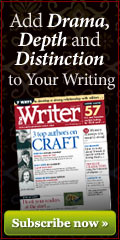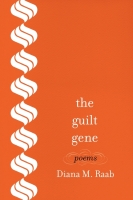Issue 2 - Winter 2010 Reviews Anxious Music Blood Dazzler Cities of Flesh and the Dead Crazy Love Cures and Poisons Dark Card and Mom's Canoe Fire Pond How to Live on Bread and Music Mister Skylight Paternity Perpetual Care Pictures in the Firestorm Rhapsody of the Naked Immigrants Rock Vein Sky Six Lips Slaves to Do These Things Slide Shows The Air around the Butterfly The Guilt Gene the nested object Interviews
 |
Diana Raab's second collection contains poems from many facets of the narrator's life. The book, The Guilt Gene, gives us the sense of a single narrator across time and space, showing her at many stages, serving many roles. She is caretaker and patient; granddaughter, daughter and mother; writer, lover and wife. We see her as sentimental in one poem and angry in the next, sometimes a fragile child, sometimes an indignant young woman. The narrator both apologizes and makes no apologies. She shares wishes, memories, dreams and disappointments. When considered independently, each poem is straightforward. Rarely do Raab's words disguise her subject matter in metaphor. Instead, she mainly relies upon narration and physical detail to unfold the poems. Raab engages our five senses with objects like corduroys, moth balls, powdered milk, Noxema, reefers and library cards. "Straightforward," however, should not be assumed to imply "simple." There are many tricks up Raab's sleeve. One of them is the proliferation of surprises. The narrative poem "Displaced Watermelons" offers a wonderful image on which to focus Raab's talent for surprising her readers. A woman walks the beach with her dog, and they come across "three whole watermelons/ one-hundred feet apart." She refers to them as "titanic fruits/ so out of place." Often, Raab uses surprise in this way, placing something, like the watermelons, out of context within a single poem. Other times, it is her overall approach to the poem -- showing us something that seems entirely foreign to the collection as a whole -- that surprises us. In "Empty Dreams," we encounter violent imagery, which is not typical in the book, when the narrator reveals: "I take/ my screwdriver into the frontal/ part of my brain, ignoring the drips/ of blood." The narrator shows us her sense of humor in "Author Blues," a piece that equates the period after publishing a book with post-partum depression. In the poem "The Guilt Gene," Raab provides us with surreal imagery, which is unusual in the context of the collection. In this, the title piece, the narrator imagines herself in the womb the day before her birth. She tells us:
Sometimes, it is the shift of tone from poem to poem that surprises us. Some of the poems are soft and hazy, as is appropriate for the presentation of dreams and memories, but once in a while, a poem is harsh and stark. For example, the poem "Bifurcation" is four lines long. It begins, "Having a breast sliced off." When held against the warmer images in other poems, like "When I Wear Corduroys I Think Of You" ("I think of those blue/ [corduroys] you sported ... my hands on their worn out knees/ in the movie theater"), the contrast shocks us -- as trauma should. My favorite moment of the book is the surprise that occurs in the poem "Book Tour," which details the narrator's preparations for and hopes surrounding a far-away In addition to utilizing the element of surprise, Raab's straightforward poems refuse to be simple because they tackle complicated issues. For example, she considers identity in the context of family stories (as in "Fortuna," a piece about her grandmother's typewriter and its connection with Nazi Germany), genetics (as in "Java Genetics," which begins, "Some look to their full-leafed/ family tree for maps of/ who they will become") and ancestors (as in "My Ancestors Hated Camel Herders," in which the narrator looks at a newborn and wonders how peace remains elusive). Perhaps the most prevalent complexity in The Guilt Gene is romantic love. Early in the collection, in both "Moth Balls" and "When I Wear Corduroys I Think Of You," the narrator confesses to a childhood of boys fleeing from her presence. As the collection progresses, we learn the narrator continues to struggle with the absence of the objects of her desire. In "Empty Dreams," she laments that she is not the one "to hug you in the way/ I know you need," and in "Traffic," the narrator says, "I think of my life without you" and "I'm still soaring on the fumes of you/ so nothing else matters." Even though the narrator's romantic interest is present in part of "Rendez-Vous," he disappears in the end:
While lost love haunts so many of the narrator's tales, men are not the only ghosts in The Guilt Gene. The narrator's grandmother has committed suicide, and her apparition is a presence scattered throughout the collection, as well, including the poem "Waving To Yesterday," where we visit
The collection features many gut-wrenching and emotional stories, like the inexplicable loss of the grandmother. Still, The Guilt Gene's most heart-breaking piece is its final poem, "Old Dog." Anyone who understands how humans bond with animals will experience grief in the reading of the piece, even when read independently of the collection. But through craft -- Raab makes certain the dog (or a dog) has been a constant, though subtle, companion throughout the book -- she delivers quite a blow in telling us, "it will be the last time/ I'll see those brown eyes/ that I have loved all these years." The diversity of both subject matter and method of delivery deepen readers' experiences of the poems, as we come to know better and better the voice behind them. The charming and friendly narrator, with whom we identify, seems part of our world outside literature. We even catch a glimpse of her behind the scenes. She peels back the curtain and reveals her process in the list poem "Where I Write." Raab (or the narrator we believe is Raab) writes at "the dog groomer shop," "the picnic table in the park," "the slow elevator" and at least two dozen other places. We get the impression that she is writing all the time. This piece gives us many clues about how Raab accomplishes the task of capturing so many facets of her life in poetry: she works consistently to put down on paper as many moments as she can.
Reviewed by Carolee Sherwood. |
